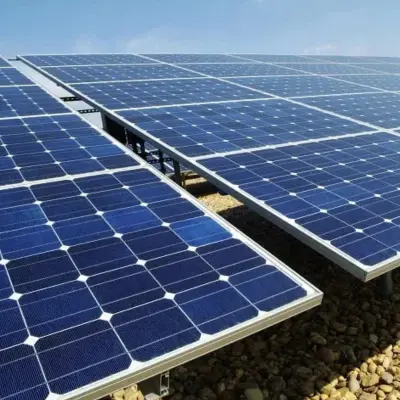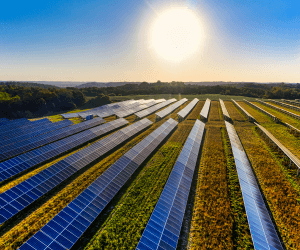
2 MW Solar Plant Project Details
Looking to 2 MW Solar Power Plant in India? Get complete details about solar farms Cost, Output, Profit, land area requirement, Specifications, RoI, etc..
2 MW Solar Plant
Synergy Solar Solutions offers fully integrated, turnkey solar solutions for commercial, industrial, and institutional clients across the country. Our 2 MW solar systems are designed for high efficiency, reliable performance, and long-term savings.
Whether you’re running a manufacturing unit, an educational institution, or a commercial facility, a 2 MW solar installation can help you reduce electricity bills, stabilize energy costs, and meet your sustainability goals.
What is a 2 MW Solar Power Plant?
A 2 MW (Megawatt) solar power plant generates approximately 8,000 units (kWh) per day under ideal sunlight conditions in India, or about 24,00,000–28,00,000 units per year, depending on location and system efficiency.These systems serve factories, IT parks, manufacturing units, and large institutions aiming to:
- Reduce power bills
- Achieve energy independence
- Sell excess electricity to the grid
- Earn green credits and tax benefits
2 MW Solar Power Plant Cost in India (2024–2025)
The cost of setting up a 2 MW solar plant varies depending on location, component quality, and installation complexity. However, the average total project cost ranges from INR 8.5 crore to 10 crore.
| 2 MW Solar Farm Investment Description | Estimated Cost / Price |
| 2 MW Solar Panels | 5.8 Crores |
| 2 MW Solar Inverter | 1.95 Crore |
| Combiners + Junction Boxes | 39.2 Lakhs |
| Protective Gears Arrangement | 19.6 Lakhs |
| SCADA & Data Logger System | 13.7 Lakhs |
| 2 MW solar power plant land requirement | *10 Acre |
| Erection Cost of 2 MW | 98 Lakh |
| Total Project Cost of 2 MW Solar Farm | 9.54 Cr. (Approx.) |
Note: 2mw solar power plant cost depend on brand of solar panels (Mono PERC, Bifacial, Polycrystalline), inverter quality, mounting structure, and land/site conditions.
Land Area Requirement for a 2 MW Solar Power Plant
The space required for a solar installation is a critical planning factor.
General Rule: Rooftop Installation: ~18,000–22,000 sq. ft (with structural feasibility),Ground-Mounted System: ~8–10 acres of shadow-free land depending on panel efficiency and layout optimization.
Factors Influencing Land Size
- Panel efficiency: Higher efficiency panels reduce area needed.
- Tilt angle: Optimal sun exposure in north-south facing layout may need spacing.
- Shading: Requires 100% shadow-free exposure from 9 AM to 4 PM.
- Maintenance pathways: Necessary for cleaning, inspection, and repairs.
Specifications of 2 MW Solar Power Plant
| Specification | Detail |
| Power Output | 8,000 kWh/day, 29.2 lakh/year |
| Plant Type | On-grid / Off-grid / Hybrid |
| Panel Type | Monocrystalline/Polycrystalline |
| Inverter Type | Central or String Inverters |
| Optional Add-ons | Batteries, SCADA |
| Warranty | 25 years (panels), 5-10 (inverter) |
Various Types of 2 Megawatt Solar Plant
There are three key types of 2 MW solar installations:
- On-Grid Solar Plant – Connected to the electricity grid; best for industries.
- Off-Grid Solar Plant – With battery backup; ideal for remote locations.
- Hybrid Solar System – Combines grid + batteries; maximum energy security.
On-Grid 2 MW Solar Power Plant (Grid-Tied)
An on-grid or grid-connected 2 MW solar system is directly linked to the public electricity grid (DISCOM). It is ideal for commercial buildings, factories, or institutions that have high daytime energy usage.
Features & Advantages:
✅ No Battery Required: Energy flows directly to the load or grid, reducing system cost.
✅ Power Sale via PPA / Gross Metering: Surplus energy is exported to the grid under a long-term Power Purchase Agreement (PPA) or state-specific gross metering policy, generating steady and predictable income.
✅ Cost-Effective Setup: Cheapest among all 2 MW system types due to fewer components.
✅ Efficient Use of Solar Power: Pulls power from the grid only when solar production is insufficient.
✅ Ideal for Urban & Industrial Use: Suitable for factories, commercial spaces, and campuses with reliable grid support.
2 MW Off-Grid Solar Power Plant (Standalone)
An off-grid solar plant operates independently without any connection to the local electricity grid. It stores generated energy in large battery banks and supplies power 24/7, even during the night or cloudy days.
Features & Advantages:
✅ Battery Backup: Stores excess power for night-time or cloudy-day use.
✅ Remote Operation: Perfect for rural or inaccessible locations without grid supply.
✅ Energy Independence: Eliminates electricity bills and grid dependency.
✅ High Reliability: Critical systems remain operational even during blackouts.
✅ Suitable for Mission-Critical Operations: Great for mining, agriculture, defense sites, or remote industrial units.
Hybrid 2 MW Solar Power Plant (Grid + Battery)
A hybrid solar plant combines grid-tied and battery-backed systems. It offers both PPA/gross metering benefits and energy backup, ensuring round-the-clock power availability.
Features & Advantages:
✅ Dual Functionality: Draws power from solar, battery, or grid as per need.
✅ PPA + Backup: Surplus energy can be exported to the grid under a PPA, while batteries store power for use during outages.
✅ Uninterrupted Power Supply: Ensures continuous operation during grid failures or night-time.
✅ Advanced Energy Management: Ideal for sensitive equipment or operations requiring stable voltage.
✅ Best of Both Worlds: Suitable for commercial establishments needing grid interaction and backup.
Return on Investment (ROI) for a 2 MW Solar Power Plant in India
Understanding the income from a 2 MW solar power plant is essential for investors, industrial users, and project developers. A 2 MW plant not only reduces operational power costs but also generates steady revenue through energy export under PPA/gross metering, especially when long-term agreements with DISCOMs or private buyers are in place.
| ROI Parameter | Value Estimate |
| Daily Energy Output | ~8,000 kWh |
| Annual Energy Output | ~29.2 lakh units |
| Tariff Rate (DISCOM/CERC Avg.) | ₹3.85/unit (varies by state policy) |
| Gross Annual Revenue | ₹1.12 crore |
| Annual O&M & Misc. Costs | ₹16–20 lakh |
| Net Annual Income | ₹92 lakh – ₹96 lakh |
| Payback Period | 6 to 8 years |
| Project Life | 25–30 years |
| Internal Rate of Return (IRR) | 12% to 16% (typical range) |
How 2 megawatt solar system Improves Business ROI
- Energy Cost Savings: Reduces or eliminates monthly electricity bills.
- Revenue from Surplus Power: Through long-term Power Purchase Agreements (PPAs) or state-specific Gross Metering policies.
- Depreciation Benefits: Under Section 32 of the Income Tax Act, you can claim up to 40% accelerated depreciation, reducing taxable income.
- Minimal Maintenance: Annual O&M costs are predictable and low, enhancing lifetime profitability.
- Protection from Tariff Inflation: Solar locks in your energy cost, shielding you from rising grid prices.
Example ROI Scenario
If your plant exports 2.9 million units annually at ₹3.85 per unit, you earn ₹1.12 crore/year. After deducting ₹16 lakh in annual maintenance, you net ~₹96 lakh. With an upfront investment of ₹9.5 crore (CAPEX model), your breakeven occurs within 6–8 years—after which you enjoy free electricity and consistent revenue for another 17–20 years.
2 MW Solar Power Plant Project Report (Key Financials)
Here is a 2MW solar power plant project report to showcase an estimated series for this system capacity.
| Particulars | Description |
| Power Plant Capacity | 2-megawatt |
| Annual power generation | 29.20 Lakh (On Average) |
| Degradation over the first decade (1 to 10 years) | 0.05% per year |
| Degradation from 11 to 25 years | 0.67% per year |
| Debt Percentage | 70% |
| Equity Percentage | 30% |
| Rate of Interest (Indian) | 13.00% |
| Rate of Interest (Foreign) | 10% |
| Repayment Period (Indian) | 11 years |
| Repayment Period (Foreign) | 15 Years |
| Percentage of Indian Loan | 70% |
| Sale of Electricity | Rs.6.49 |
| Cost of Project (per MW) | 450 Lakh |
| O&M Cost (per MW) | 8 Lakh/year |
| Depreciation | 5.28% |
| Corporate Tax | 30.28% |
| Minimum Alternate Tax | 18.38% |
| Project Cost | 9 crore |
| Debt | 7.10 crore |
| Equity | 1.9 crore |
Investment Models for 2 MW Solar Plants
Investing in a 2 MW solar power plant requires careful planning and the right financial model to align with your operational and budgetary goals. There are two widely accepted investment models for 2 MW solar plants in India: the CAPEX model and the OPEX model (also known as PPA – Power Purchase Agreement).
Each model has distinct advantages depending on your cash flow preference, ownership interest, and long-term objectives.
CAPEX Model
One-time investment by the owner
Full control of assets and energy
Ideal for high CAPEX budget
OPEX / PPA Model
No upfront cost
Pay per unit via Power Purchase Agreement
Energy savings from day one
2 MW Solar Project Installation Process
Installing a 2 MW solar power plant in India involves 7 key stages to ensure smooth execution, regulatory compliance, and optimal performance:
- Feasibility Study :Site analysis, energy yield estimation, and ROI projections.
- System Design & Engineering: Customized plant layout, inverter sizing, and technical drawings.
- Approvals & Grid Connectivity: DISCOM permissions, CEIG approvals, and grid application filing.
- Procurement & Civil Work: Equipment sourcing, land development, and foundation setup.
- Installation & Wiring: Mounting panels, connecting inverters, and protection systems.
- Testing & Grid Synchronization: Electrical testing, energy meter setup, and grid connection.
- Commissioning & Handover: Final inspection, system training, and performance monitoring setup.
Total Duration: ~3 to 4 months depending on state approvals and site readiness.
Why Choose Synergy Solar for Your 2 MW Solar Project?
- Experience: 10+ years in solar EPC for industrial clients across India.
- Quality: We use Tier-1 modules, BIS-approved inverters, and premium-grade cabling.
- Turnkey EPC Services: From design to documentation and commissioning.
- Compliance & Safety: Adhere to MNRE, DISCOM, and safety regulations.
- Performance Guarantee: We ensure generation assurance with uptime >99%.
- Support: Dedicated O&M services, AMC, and real-time performance tracking.
FAQ- 2 MW Solar Plant
How many solar panels are required for a 2 MW plant?
A Around 4,000–5,000 panels, based on panel wattage.
Which financing model is more advantageous: OPEX or CAPEX?
Both models have their own set of pros and cons. If your business can make the required capital expenditure, you can easily become a solar owner. On the other hand, if you don’t have the flexibility of paying a heavy amount in one go, you can consider signing the PPA agreement under the CAPEX model. This way you pay a much lesser per-unit tariff rate on a monthly basis for a period of 10-25 years.
Is it difficult to operate and maintain a big power plant of 2-megawatt capacity?
Operating and maintaining your 2MW solar power plant is easier than you think. Solar panels require a basic cleaning routine and use a simple cleaning kit. Keeping your solar panels’ surface free of any accumulation is important to maintain their efficiency levels.
How many solar panels Array make up a 2MW solar power plant?
Determining the number of solar panels / Array your solar plant requires is important to figure out the 1-acre solar farm cost in India and the area required to install it. If you go for high-quality solar panels of around 400 watts each, your solar plant will require approximately 2500 panels.
How long do solar panels last?
Solar PV modules are the main component in all types and sizes of solar power plants. Most manufacturers provide a performance warranty of 25 years. In most cases, these solar panels continue to generate power for post the warranty period, however, at a reduced capacity level.
Need Even More Power?
See Our Related Solar Power Solutions

1MW solar plant

3MW solar plant
Tags: 2 mw solar plant / farm area | 2 mw solar plant cost in India | solar inverter price | 2 mw solar plant power generation | 2 MW Solar Array | cost of installing 2 mw solar power plant in India | 2 mw solar power plant return on investment
